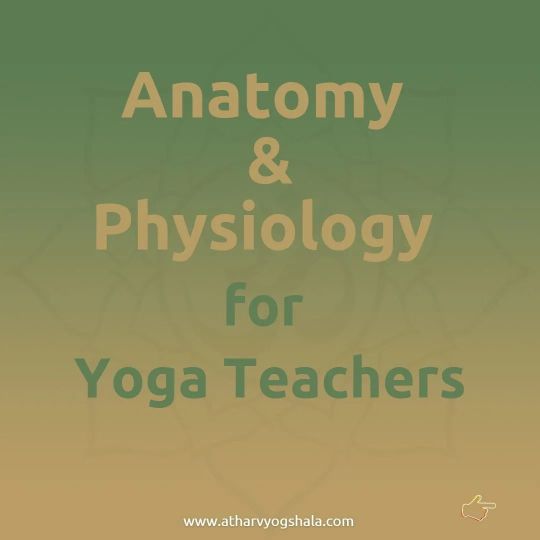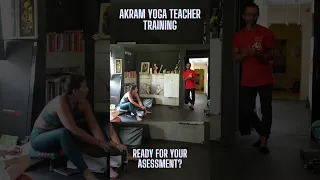#AnatomyOfYoga
Text

Yoga is one of the most popular forms of exercise that has a great impact on our physical and mental health.
To understand its impact, it is important to know the inner structure and functioning of the body.
As a yoga teacher or practitioner, you must be familiar with the limitations of each body type and its level of experience.
Therefore teachers must learn about the basics of anatomy and physiology to understand what’s going on in the body and achieve the full benefits of yoga.
What is Yoga Anatomy?
Anatomy is a medical term and it deals with the study of basic structures of the body. Its teaching includes the study of bones, muscles, joints, and other internal organs of the body.
All Yoga teachers need to understand the structure of the human body to increase the effectiveness of asanas and protect the body from injuries.
With this anatomical awareness you will be prepared to deal with injuries in an effective, yet protected manner.
What is Yoga Physiology?
Yoga Physiology is the science that deals with the functioning of the body parts and their specific roles.
Its teaching includes the study of the function of different organs like respiration, reproduction, digestion, osmoregulation, and a lot more.
It is a dynamic study that reveals how different systems in the body function collectively as a single unit that is moved by energy.
Anatomy vs Physiology
The word ‘anatomy’ refers to the ‘structure of body’, while ‘physiology’ refers to ‘function of the body’.
In the anatomy of yoga, you will learn about the detailed structure of different parts and organs of the body.
Whereas in yoga physiology you will be studying the functions of these body parts and organs in a coordinated way.
These two terms are often studied jointly and are incomplete without each other. One needs to know anatomy before acquiring the knowledge of physiology, conversely, only studying anatomy without understanding physiology is simply worthless.
#anatomyofyoga#anatomy#yoga#yogateacher#yogapractice#anatomyandphysiology#yogajourney#anatomystudy#anatomynerd#anatomypractice#yogaanatomy#yogainspiration#anatomyforyogis#anatomyinmotion#anatomyartwork
2 notes
·
View notes
Text

The BSc in Yoga course encompasses a holistic exploration of yoga philosophy, anatomy, and practical techniques. Students delve into ancient yogic scriptures, learning the philosophical foundations of yoga and its relevance to modern life. Anatomy and physiology modules provide a scientific understanding of the body's response to yogic practices. Practical aspects include mastering traditional asanas (postures), pranayama (breath control), and meditation techniques. Students also explore the therapeutic applications of yoga for physical and mental well-being. The curriculum emphasizes teaching methodologies, empowering students to become proficient yoga instructors. This comprehensive program blends tradition with contemporary knowledge, fostering a deep appreciation for the transformative power of yoga.
Website: https://skvv.co.in/
#BScYoga#YogaPhilosophy#AnatomyOfYoga#YogaScience#AncientWisdom#HolisticHealth#MindBodySpirit#YogaInstructor#MeditationJourney#PranayamaPractice#TherapeuticYoga#WellnessEducation#YogaTradition#ModernYogi#YogaLife#MindfulnessTraining#AsanaMastery#YogaStudies#BodyMindConnection#HealthyLiving#TransformativeEducation#AncientAndModern#YogaTeacherTraining#YogaCurriculum#SpiritualWellness#HolisticLearning#MindfulLiving#YogaForHealth#WellBeingJourney#YogaCommunity
0 notes
Text
Ready for your assessment? / Yoga Teacher Training

Embark on a Journey of Self-Discovery with Our Yoga Teacher Training Program! 🧘♂️ Join us for an immersive and transformative Yoga Teacher Training experience that goes beyond the asanas. Dive deep into the philosophy, anatomy, and art of teaching yoga, guided by experienced instructors. Whether you're looking to become a certified yoga teacher or deepen your practice, this program offers a holistic approach that nurtures your mind, body, and soul. Get ready to embrace growth, gain confidence, and spread the gift of yoga to others. 🌱🕉️
#YogaTeacherTraining #YogaJourney #YogaCertification #TransformativeExperience #MindBodySoul #DeepenYourPractice #YogaPhilosophy #AnatomyOfYoga #EmpowerThroughYoga #SpreadPositivity #SelfDiscovery #YogaInstructorTraining
0 notes
Photo

Vastus lateralis Description Spans from the anterior and lateral compartment of the thigh. The vastus lateralis forms the anterior (or extensor) compartment of the thigh with rectus femoris, the vastus medialis, and the vastus intermedius. The muscles together are called the quadriceps femoris. It extends the knee. Origin Linea aspera of femur, greater trochanter of femur Insertion Tibial tuberosity (via patellar ligament) (lateral condyle of femur) - Tibial tuberosity (via patellar ligament) (condyle away from the center of the femur) - Lateral = Body part that is farther from the middle or center of the body Nerve supply Femoral nerve (L2-L4) which is the largest branch of the lumbar plexus. Blood supply Lateral circumflex femoral artery Action Knee joint: Leg extension Reference https://www.kenhub.com/en/library/anatomy/the-quadriceps-femoris-muscle . . . #discoverphysiotherapy #physiotherapy #anatomy #anterior #thigh #vastus #orgin #insertion #lateral #artery #blood #action #anatomyscan #anatomystudy #anatomytips #anatomytrains #anatomyedit #neuroanatomy #anatomyofyoga #bone #muscle #boné #musclecars #musclegain #uni #university #student #physiostudent #notes #prettynotes https://www.instagram.com/p/CFHVKUmHasJ/?igshid=ooqc032i6or9
#discoverphysiotherapy#physiotherapy#anatomy#anterior#thigh#vastus#orgin#insertion#lateral#artery#blood#action#anatomyscan#anatomystudy#anatomytips#anatomytrains#anatomyedit#neuroanatomy#anatomyofyoga#bone#muscle#boné#musclecars#musclegain#uni#university#student#physiostudent#notes#prettynotes
0 notes
Video
Repost from @iarechabalayoga Anatomía de Ustrasana. Gabriella Giubilaro . . . #ustrasana #anatomy #anatomyandphysiology #anatomyofyoga #yogaanatomy #body #yogabody #yogaasana #asana #yogapose #iyengar #yoga #iyengaryoga #yogamelbourne #yoganorthcote #northcote #yogalife #yogalove #yogainspiration #instayoga #yogaeveryday #onthemat https://www.instagram.com/p/Boocc9inwzZ/?utm_source=ig_tumblr_share&igshid=1v1xyp88pxvh1
#ustrasana#anatomy#anatomyandphysiology#anatomyofyoga#yogaanatomy#body#yogabody#yogaasana#asana#yogapose#iyengar#yoga#iyengaryoga#yogamelbourne#yoganorthcote#northcote#yogalife#yogalove#yogainspiration#instayoga#yogaeveryday#onthemat
0 notes